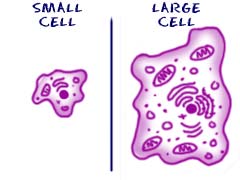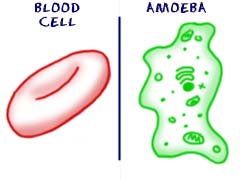1.- THE CELL
Cells are the Starting Point All living organisms on Earth are divided in pieces called cells. There are smaller pieces to cells that include proteins and organelles. There are also larger pieces called tissues and systems. Cells are small compartments that hold all of the biological equipment necessary to keep an organism alive and successful on Earth. All living organisms on Earth are divided in pieces called cells. There are smaller pieces to cells that include proteins and organelles. There are also larger pieces called tissues and systems. Cells are small compartments that hold all of the biological equipment necessary to keep an organism alive and successful on Earth. A main purpose of a cell is to organize. Cells hold a variety of pieces and each cell has a different set of functions. It is easier for an organism to grow and survive when cells are present. If you were only made of one cell, you would only be able to grow to a certain size. You don’t find single cells that are as large as a cow. Also, if you were only one cell you couldn’t have a nervous system, no muscles for movement, and using the internet would be out of the question. The trillions of cells in your body make your life possible. One Name, Many Types There are many types of cells. In biology class, you will usually work with plant-like cells and animal-like cells. We say animal-like because an animal type of cell could be anything from a tiny microorganism to a nerve cell in your brain. Plant cells are easier to identify because they have a protective structure called a cell wall made of cellulose. Plants have the wall; animals do not. Plants also have organelles like the chloroplast (the things that make them green) or large water-filled vacuoles.  We said that there are many types of cells. Cells are unique to each type of organism. Humans may have hundreds of types of cells. Some cells are used to carry oxygen (O2) through the blood (red blood cells) and others might be specific to the heart. If you look at very simple organisms, you will discover cells that have no defined nucleus (prokaryotes) and other cells that have hundreds of nuclei (multinucleated). The thing they all have in common is that they are compartments surrounded by some type of membrane. |
The cell nucleus acts like the brain of the cell. It helps control eating, movement, and reproduction. If it happens in a cell, chances are the nucleus knows about it. The nucleus is not always in the center of the cell. It will be a big dark spot somewhere in the middle of all of the cytoplasm (cytosol). You probably won’t find it near the edge of a cell because that might be a dangerous place for the nucleus to be. If you don’t remember, the cytoplasm is the fluid that fills cells. |
CELL FUNCTIONS All cells have a purpose. If they don’t do anything productive, they are not needed anymore. In the big picture, a cell’s purpose is much more important than acting as small organizational pieces. They had their purpose long before they started working together in groups and building more advanced organisms. When alone, a cell’s main purpose is to survive. All cells have a purpose. If they don’t do anything productive, they are not needed anymore. In the big picture, a cell’s purpose is much more important than acting as small organizational pieces. They had their purpose long before they started working together in groups and building more advanced organisms. When alone, a cell’s main purpose is to survive. Even if you were a single cell, you would have a purpose. You would have to survive. You would be moving around (probably in a liquid) and just trying to stay alive. You would have all of your pieces inside of you. If you were missing a piece you needed to survive, you would die. Scientists call those pieces organelles. Organelles are groups of complex molecules that help a cell survive. All Cells are not Created Equal In the same way that cells survive in different ways; all cells have different types and amounts of organelles. The larger a cell becomes the more organelles it will need. It makes sense if you think about it. If you are a big cell, you will need to eat more than a little cell. You will also need to convert that food into energy. A larger cell would need to eat more and may wind up having more mitochondria to process that food into energy. In the same way that cells survive in different ways; all cells have different types and amounts of organelles. The larger a cell becomes the more organelles it will need. It makes sense if you think about it. If you are a big cell, you will need to eat more than a little cell. You will also need to convert that food into energy. A larger cell would need to eat more and may wind up having more mitochondria to process that food into energy. While they might have a purpose, more advanced cells have a difficult time surviving on their own. A cell from your brain could not survive in a Petri dish for long. It doesn’t have the right pieces to live on its own. It does have the ability to transmit electrical systems around your body. An amoeba could survive in a dish forever, thrive, and reproduce. On the other hand, that amoeba will never help you transmit electrical impulses. The brain cell is far more advanced and has specific abilities and organelles. Simpler cells have a better chance of surviving on their own while complex cells can accomplish tasks that are more advanced.
|
 We suppose it would be good to know what happens during those phases. Always remember - PMATI!
We suppose it would be good to know what happens during those phases. Always remember - PMATI! Anaphase:
Anaphase:
0 comentarios